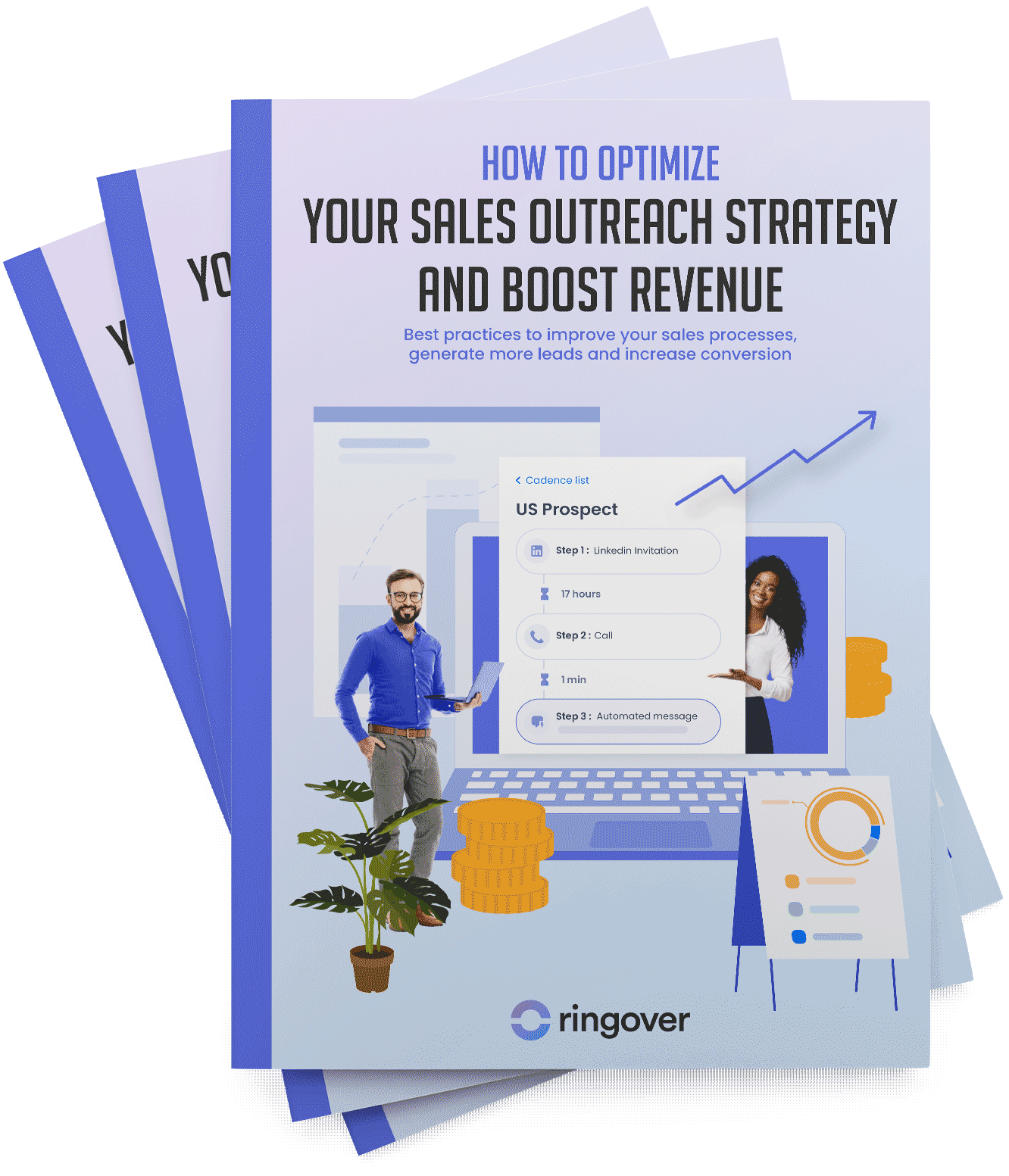Summary
The success of a prospecting campaign doesn't depend on the company's reputation or the sales team's talent. Various factors come into play. The plan implemented must align with the company's strategic and commercial objectives and the products or services sold. This deployment must be well-organized to derive all the benefits possible.
Here are some tips to help you succeed in your prospecting campaign.
What Is a Prospecting Campaign?
A prospecting campaign is the process of identifying and contacting prospects to develop a customer portfolio. The main objective of a prospecting campaign is to create interest in a company's products or services among potential customers.
5 Types of Prospecting Campaigns (With Examples)
Companies can choose from a variety of sales prospecting campaigns to attract and convert prospects. Here are some popular types of prospecting campaigns with concrete examples:
- Cold calling campaigns: This method involves directly contacting prospects by phone without prior interaction. For example, a B2B cloud telephony company might call businesses to present its products to improve their business phone system.
- Emailing campaigns: Companies send targeted emails to a specific group of prospects, usually using sales prospecting email templates. An example would be a software company sending automated email sequences with information about their latest product.
- Social selling campaigns: Selling on social networks involves using platforms like LinkedIn, Twitter, or Facebook to build relationships with prospects and customers. A salesperson might share relevant content, participate in discussions, and directly contact prospects on LinkedIn.
- Content marketing campaigns: This form of prospecting attracts customers by creating and sharing useful and relevant content. A company blog offering relevant advice to its industry can attract prospects interested in these topics. It can also create downloadable white papers on lead generation platforms, which capture prospect information.
- Trade shows and events: Participating in industry events where you can meet prospects in person, showcase your products, and expand your network. For example, a high-tech company might have a booth at a trade show to present its innovations and also make contacts.
What Are the Steps of a Good Prospecting Campaign?
It is very important to adopt a methodical approach to initiate and succeed in your campaign. Below, we list seven steps to follow to successfully carry out your campaign:
1. Clearly Define the Objectives of the Campaign
Before starting any prospecting action, it is necessary to precisely define what you want to accomplish. Whether it is acquiring new customers, re-engaging inactive prospects, or promoting a new product/service, your objectives must be clear, measurable, and aligned with your company's overall strategy. This first step is somewhat of a brief that will help you frame your campaign. During this step, be sure to ask yourself the following questions:
- What is the product offer? What are the services/products to be promoted?
- What are the selling points I want to highlight?
- How long should my campaign last?
- What are my business objectives?
2. Identify and Segment Your Target
The success of a prospecting campaign largely depends on the quality of the segmentation of your target audience. Analyze your market and identify the customer segments most likely to be interested in your products or services. This segmentation will allow you to tailor your message and approach based on the specific needs and characteristics of each segment.
Here are some examples of questions to ask yourself during this second step:
- What are the demographic traits of our target audience? (age, gender, place of residence, profession, income, etc.)
- What are the specific needs and challenges of our target audience? (problems they seek to solve, unmet needs, etc.)
- What are the characteristics of our target audience? (values, interests, behaviors, preferences, etc.)
- What are the potential objections our target audience might have regarding our product or service? (price, quality, usefulness, etc.)
- What are the current trends or market changes that could influence the needs of our target audience?
- Who are the competitors targeting the same audience as us? (their strategies, strengths, and weaknesses)
- What segments of our target audience are the most profitable or promising for our company?
- How does our offer stand out to meet the specific needs of each segment of our target audience?
- What data is available about our target audience that we can use to personalize our prospecting approach? (purchase history, online behavior, etc.)
3. Build a Database of Qualified Prospects
Once your target is identified, proceed to build a database of qualified prospects.
This database must be updated regularly and include relevant information about each prospect, such as their needs, preferences, contact details, etc.
You can use different sources to build your database, including social networks, trade shows, directories, etc.
4. Develop a Striking and Personalized Message
The key to successful prospecting lies in the ability to capture your prospects' attention from the first moments.
To do this, it is crucial to design a clear, concise, and specific message that highlights the benefits of your products or services for the prospect.
Personalize your message by considering the specific needs, challenges, and interests of each prospect.
5. Choose the Right Communication Channels
Select the most appropriate communication channels to reach your target audience.
Depending on your prospects' profile, you can opt for multichannel approaches, such as phone calls, emails, social networks, professional events, etc. An omnichannel contact center software can go far in supporting multichannel communications, helping you to reach your prospects on the right channel, at the right time.
Be sure to adapt your message and approach to each communication channel to maximize the impact of your campaign.
To successfully carry out your multichannel prospecting campaign, Ringover has developed a solution called Cadence. It helps you standardize your approach by identifying the most effective sales sequences, also known as sales cadences.
6. Implementing an Action and Follow-up Plan
Develop a detailed action plan outlining the different stages of your prospecting campaign, as well as the responsibilities of each member of your team.
Ensure that tools are in place for tracking and measuring the performance of your campaign, such as dashboards, key performance indicators (KPIs), satisfaction surveys, etc.
These tools will allow you to analyze the results of your campaign and make necessary adjustments in real-time.
7. Ensuring Effective Follow-up with Prospects
Prospecting does not stop at the first contact. To maximize your chances of conversion, make sure to implement an effective follow-up process with prospects.
Follow up with prospects who have shown interest in your products or services, provide them with additional information, answer their questions, and offer solutions tailored to their specific needs.
Regular and personalized follow-up with prospects is essential to maintain the relationship and encourage them to take action. Here again, a solution like Cadence by Ringover can be very useful.
The Different Prospecting Tools
There is a plethora of tools available to companies to help them create and track their prospecting campaigns. From social media to CRMs, including emailing solutions, sales prospecting software, and VoIP software, the options are numerous.
The key to success lies in the strategic combination of these tools and the channels associated with them. This mix allows for more targeted and therefore more effective campaigns.
10 Prospecting Tools
| Prospecting Tool | Main Functionality |
|---|---|
| Cadence | Standardize multichannel prospecting campaigns |
| Ringover | Manage business telephony (prospecting, customer service, reception, etc.) |
| Empower | Analyze and optimize phone-based interactions |
| LinkedIn Sales Navigator | Prospecting and prospect search tool on LinkedIn |
| Hunter.io | Search and verification of email addresses |
| HubSpot | Marketing automation platform and CRM |
| Salesforce | CRM for sales and customer management |
| Sellsy | CRM and business management software |
| Zoom Info | Database for sales prospecting |
| Monday CRM | Platform for sales and customer management |
What are the mistakes to avoid when prospecting?
Premature project launch, understaffing, restructuring, etc., many events can impact your prospecting.
Even within the best organizations, there can be one or two errors which impede prospecting campaigns from attaining the best results. Here are a few of the most common mistakes to avoid.
- Lack of preparation: Improvised prospecting is often ineffective. It is crucial to prepare your pitch and be well-acquainted with your products or services before starting your campaign.
- Not listening to the prospect's needs: Taking the time to make a phone call to a prospect for a monologue is pointless. Each interaction by phone, email, or any other channel should be an opportunity to gather valuable information about their issues and needs. Conversational analysis tools like Empower can help you measure your speaking time and better manage it.
- It is essential to ask questions to understand the specific needs of the prospect and tailor your speech accordingly.
- Not building a relationship with the prospect: Prospecting is not just about selling, it is primarily about building a relationship. Not taking the time to establish a connection with the prospect can make the conversation cold and impersonal.
- Being too persistent: Harassing a prospect can damage the company's image and jeopardize the chances of closing a sale. It is important to respect the prospect's pace and preferences.
- Focusing on a single prospecting channel: Avoid putting all your eggs in one basket. It is recommended to adopt a multichannel approach to increase your chances of contacting more prospects.
- Not following up with the prospect: Follow-up is necessary to maintain the prospect's interest and guide them through the sales process. Failing to follow up can make your proposal forgotten and reduce your chances of conversion.
What to Remember
To maximize the effectiveness of your prospecting campaign, it is imperative to strategically combine the right tools and channels to achieve the perfect mix. It is also important to sufficiently frame your prospecting to properly distribute your efforts and improve your results.
Solutions such as Cadence, Ringover, and Empower are essential assets in this process. Their use can greatly facilitate the standardization of your campaigns, their tracking, the analysis of your exchanges, and the management of your calling campaigns.
By integrating these tools into your strategy, you can optimize your results and strengthen your impact on the market.
To learn more, you can already register for free on our site and request a personalized demonstration or trial.
Prospecting Campaigns FAQ
How to run a good prospecting campaign?
- Define your target: Before starting any prospecting campaign, it is essential to precisely understand who your potential customers are. Analyze your current customers to identify demographic characteristics, needs, and buying behaviors. This will help you effectively target your prospecting efforts.
- Develop a striking message: Your prospecting message should be clear, concise, and captivating. Highlight the benefits and solutions that your product or service offers to your prospects. Show them how you can solve their problems or meet their needs better than anyone else.
- Choose the right prospecting channels: There are many prospecting methods, ranging from email marketing and social media to phone calls and networking events. Select the channels that are most likely to effectively reach your target audience.
- Establish a follow-up plan: Prospecting does not end with the first interaction. Make sure you have a plan in place to follow up with your prospects after the first contact. This may include follow-up calls, sending relevant content by email, or even in-person meetings to deepen the relationship.
- Measure and adjust: Monitor the performance of your prospecting campaign by tracking metrics such as conversion rate, return on investment, and the number of qualified prospects. Use this data to adjust your approach as you go and maximize your effectiveness.
What are the 5 steps of a prospecting plan?
Here are the 5 steps of a good prospecting plan:
- Definition of prospecting objectives: Establish clear and measurable objectives for the prospecting campaign.
- Qualify your prospects: Identify and segment prospects based on your ideal customer.
- Choice of prospecting methods: Select the channels and techniques best suited to reach the prospects.
- Prepare your script and anticipate objections.
- Follow-up and evaluation of results: Measure the campaign's performance and adjust strategies if necessary.
What are the methods of prospecting?
Prospecting methods vary depending on several factors, including the type of business, the target market, and available resources. Here are some of the most commonly used methods:
- Email marketing: Sending personalized and targeted emails to present your products or services to prospects.
- Cold calling: Calling potential prospects to inform them about your company and assess their interest.
- Networking: Participating in networking events to build professional relationships and generate prospects.
- Content marketing: Creating and sharing informative and relevant content to attract the attention of prospects.
- Social media: Using social platforms to interact with prospects and promote your business.
- Word of mouth: Encouraging your satisfied customers to recommend your business to their network.
What is a prospecting action?
A prospecting action refers to any activity undertaken with the aim of seeking and generating prospects for a business. This may include sending prospecting emails, making phone calls to potential prospects, participating in trade shows to meet new contacts, or any other initiative aimed at expanding the base of potential customers. In short, any action aimed at identifying and engaging qualified prospects can be considered a prospecting action.



